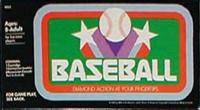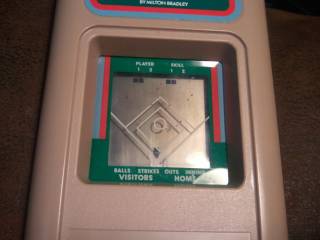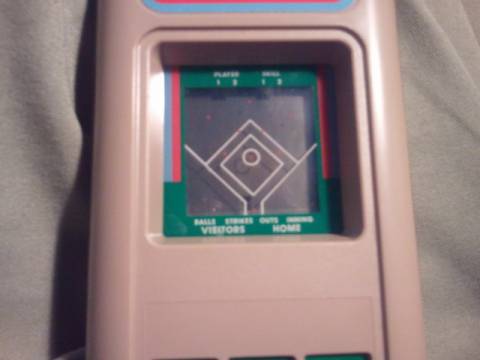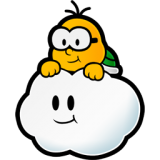History of Baseball Video Games #5 - Microvision's Baseball
By jbn566 1 Comments
This is a series of blogs based on my own personal game collection. I will attempt to go through them in a chronological order according to their release date. I will also attempt to play then on their original platform using the original controllers the game was designed for. If I am unable to get the system or the game working then I will use PC emulation or another platform emulation like the Intellivision Lives! game for the gamecube
Previous entries
1. Videocart 12 - Baseball (1977)
2. Astrocade's Tornado Baseball (1977)
3. Atari 2600's Home Run (1978)
4. Intellivision's Major League Baseball (1980)
Baseball for Microvision (1980)

For those that are unaware, The Microvision was the first cartridge based handheld video game system. During this time there were handheld dedicated units that played one game. Microvision had an LCD screen with a resolution of 16 x 16. There are reports that the system over time becomes unplayable because of the controls and old tech of LCD. I dug through my junk drawer and found an 9-volt battery and placed it in system. I feared the worst when I put the cartridge in but luckily it powered up and a 16x16 baseball game was in the palm of my hands.
Graphics

Lets be real honest with 16x16 there isn't much to work with. The game's cartridge comes with a screen overlay that has a the baseball field printed on it. This method of graphic rendering, freed up the ROM to handle all the dynamic parts. When I say dynamic parts I am referring to the dot that is the baseball, the dot that is the batter and the dots that are the base runners all moving around in a 16x16 dot box. The score nor the batter's count is displayed while you play. The cartridge includes buttons for those; when pressed, pauses the game and displays the information on the bottom of the screen. The label for these 'stats' are printed directly on the screen overlay. The LCD manages to form recognizable numbers.
Players
The LCD screen produces no fielders. The defensemen are small red reference points printed on the overlay. The batter is a LCD dot with the bat the same size dot. The batter is the pivot point and the bat rotates around 180 degrees. If you manage to get a hit, an LCD dot is placed on the base.
Field

The field is displayed on the overlay. The bases are not displayed but the foul lines, running lanes and pitcher mound are. It does form a simple yet effective baseball diamond.
Fans
No fans or crowds, besides maybe the people around you watching you play the very first handheld cartridge based baseball game
Home Run Celebration
This game supports home runs, and that is all I can expect. The celebration is simple, the bases light up as if running the bases and the score increases. The feeling of hitting a home run and watching the ball leave the field is quite a thrill even if it was just one pixel moving.
Camera/Screen
There is no other screen. The field is printed on the screen overlay in a bird's eye view. When you press the "Count" and "Score" numbers appear on the bottom; I consider this the 'pause' screen but a little weird in that the score and numbers are displayed underneath the foul lines on the overlay.
Sound
The system doesn't have a volume control, or at least I couldn't find it. But I didn't really look to hard because I loved the sound effects. I felt like I was listening to the little train that could. The game contained a little 3 beep melody when you start the game and a two tone beeps for every out that sounded like it was laughing at you; single beep for a every hit. It might be a handheld but the sound effects were on par with home consoles around this time.
Gameplay - Modes
There is two different skill levels, 1 an 2. From my play through I found skill level 2 involved the pitcher pitching crazier curves than level one. Besides the skill levels there is an option for one or two players. If playing in two players mode, you pass the system around when your team is up to bat.
Gameplay - Defense
This game is unique in that the gamer has no control of the defense. This game is offense only. The fielders are printed on the overlay so they don't move at all. If the ball is hit and lands in these fielder 'zones' it is was an out.
Gameplay - Offense
Not only is this the first handheld baseball game but one of the first where it is 100% offensive game. You only control the batter and you turn the controller's dial to do the swing. The timing of the hit controls the speed and direction of the ball. There is no control of the base runners. If you want the player on first to score you need to continue to make hits. I found this simple form of baseball really enjoyable. There is something to be said about quick gameplay fits perfect on handheld's. I wish this game was on my Nintendo 3DS just to play between traffic stops.
Rules of Baseball
This is the simplest form of baseball so far in the history of video games. It manages to take the bare bones of what makes baseball a game and runs with it. There is only a baseball that is pitched to you over and over and you have to hit the ball and have it land away from the fielders. You have the batter's count. 4 balls, 3 strikes. you play nine innings and because there is no defense only your score is actually tallied so no chance of extra innings. The game ends after nine innings. You can hit a single,double,triple and home run. There is no advanced base running or advanced fielding.
Video Game Innovations
- Handheld Cartridge
- 100% offense style game
- Screen overlay
